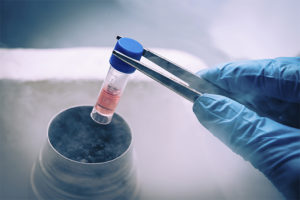Embryo freezing (cryopreservation) as part of IVF
It is very common for more eggs to be collected during a treatment cycle than can be used in that one cycle. As a result of this, there are often embryos remaining after embryo transfer. Any remaining embryos that are of suitable quality can be frozen and stored in liquid nitrogen (cryopreserved) for future use. We freeze embryos in about 50-60% of treatment cycles.
Vitrification
The freezing technique that we use at The Shropshire and Mid Wales Fertility Centre is called Vitrification. This is a rapid freezing technique with a high cell survival rate following embryo thaw.
Although the majority of embryos survive the freeze/thaw process, there is no guarantee of embryo survival, and the pregnancy rate after frozen embryo transfer is usually lower than that of fresh embryo transfers.
Frozen embryo storage
The Human Fertilisation and Embryology Authority (HFEA) state that the maximum storage period for frozen embryos is 55 years. However the maximum initial storage period is always 10 years, and consent to embryo storage may be renewed in 10 year increments, up to a maximum of 55 years. More information can be found on the HFEA website.
Frozen embryo transfer
Thawing and transfer of the frozen embryo (frozen embryo transfer cycle) may occur either in a natural cycle or a controlled cycle using drugs to create conditions ideal for embryo implantation in the uterus. In a natural cycle the patient undergoes ultrasound scanning until a follicle with a diameter of 14mm is produced. A urine ‘ovulation prediction’ test is used daily and the patient should inform the unit when the test is positive.
The actual process of transfer is identical to that used in a fresh IVF or ICSI cycle, with a catheter being used to insert the embryos into the womb. More information about IVF can be found on the IVF Treatment page.

